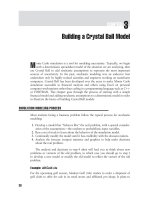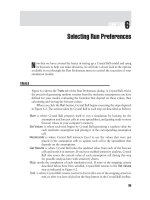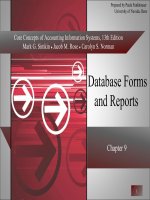Managerial decision modeling with spreadsheets by stair render chapter 09
Bạn đang xem bản rút gọn của tài liệu. Xem và tải ngay bản đầy đủ của tài liệu tại đây (201.29 KB, 31 trang )
Chapter 9:
Queuing Models
© 2007 Pearson Education
Queuing or Waiting Line Analysis
•
•
•
•
Queues (waiting lines) affect people everyday
A primary goal is finding the best level of service
Analytical modeling (using formulas) can be used for many queues
For more complex situations, computer simulation is needed
Queuing System Costs
1.
2.
Cost of providing service
Cost of not providing service (waiting time)
Three Rivers Shipping Example
•
•
•
•
•
Average of 5 ships arrive per 12 hr shift
A team of stevedores unloads each ship
Each team of stevedores costs $6000/shift
The cost of keeping a ship waiting is $1000/hour
How many teams of stevedores to employ to minimize system cost?
Three Rivers Waiting Line Cost Analysis
Number of Teams of Stevedores
1
2
3
4
Ave hours
waiting per ship
Cost of ship
waiting time
(per shift)
Stevedore cost
(per shift)
7
4
3
2
$35,000 $20,000 $15,000 $10,000
$6000 $12,000 $18,000 $24,000
Total Cost $41,000 $32,000 $33,000 $34,000
Characteristics of a
Queuing System
The queuing system is determined by:
•
Arrival characteristics
•
Queue characteristics
•
Service facility characteristics
Arrival Characteristics
•
•
Size of the arrival population – either infinite or limited
Arrival distribution:
– Either fixed or random
– Either measured by time between consecutive arrivals, or arrival rate
– The Poisson distribution is often used for random arrivals
Poisson Distribution
•
•
•
•
Average arrival rate is known
Average arrival rate is constant for some number of time periods
Number of arrivals in each time period is independent
As the time interval approaches 0, the average number of arrivals approaches 0
Poisson Distribution
λ = the average arrival rate per time unit
P(x) = the probability of exactly x arrivals
occurring during one time period
P(x) = e-λ λx
x!
Behavior of Arrivals
•
•
•
Most queuing formulas assume that all arrivals stay until service is completed
Balking refers to customers who do not join the queue
Reneging refers to customers who join the queue but give up and leave before completing
service
Queue Characteristics
•
Queue length (max possible queue length) – either limited or unlimited
•
Service discipline – usually FIFO (First In First Out)
Service Facility Characteristics
1.
Configuration of service facility
•
•
2.
Number of servers (or channels)
Number of phases (or service stops)
Service distribution
•
•
•
The time it takes to serve 1 arrival
Can be fixed or random
Exponential distribution is often used
Exponential Distribution
μ = average service time
t = the length of service time (t > 0)
P(t) = probability that service time will be
P(t) = e- μt
greater than t
Measuring Queue Performance
•
ρ = utilization factor (probability of all
servers being busy)
•
•
•
•
•
•
L = average number in the queue
q
L = average number in the system
W = average waiting time
q
W = average time in the system
P = probability of 0 customers in system
0
P = probability of exactly n customers in
n
system
Kendall’s Notation
A/B/s
A = Arrival distribution
(M for Poisson, D for deterministic, and
G for general)
B = Service time distribution
(M for exponential, D for deterministic,
S = number of servers
and G for general)
The Queuing Models
Covered Here All Assume
1.
2.
3.
4.
5.
Arrivals follow the Poisson distribution
FIFO service
Single phase
Unlimited queue length
Steady state conditions
We will look at 5 of the most commonly used queuing systems.
Name Models
(Kendall Notation)
Simple system
(M / M / 1)
Covered
Example
Customer service desk in a
store
Multiple server
(M / M / s)
Airline ticket counter
Constant service
(M / D / 1)
Automated car wash
General service
(M / G / 1)
Auto repair shop
Limited population An operation with only 12
(M / M / s / ∞ / N) machines that might break
Single Server Queuing System (M/M/1)
•
•
•
•
•
•
Poisson arrivals
Arrival population is unlimited
Exponential service times
All arrivals wait to be served
λ is constant
μ > λ (average service rate > average arrival rate)
Operating Characteristics for M/M/1 Queue
1.
Average server utilization
ρ=λ/μ
2.
Average number of customers waiting
L =
q
λ2
μ(μ – λ)
3.
Average number in system
L=L +λ/μ
q
4.
Average waiting time
W =L =
q
q
λ
λ
μ(μ – λ)
5.
Average time in the system
6.
Probability of 0 customers in system
7.
Probability of exactly n customers in system
W = W + 1/ μ
q
P = 1 – λ/μ
0
P = (λ/μ )n P
n
0
Arnold’s Muffler Shop Example
•
Customers arrive on average 2 per hour
(λ = 2 per hour)
•
Average service time is 20 minutes
(μ = 3 per hour)
Install ExcelModules
Go to file 9-2.xls
Total Cost of Queuing System
Total Cost = C
C
L
w
= cost of customer waiting time per
= average number customers in system
C = cost of servers per time period
s
s = number of servers
w
xL + C xs
s
time period
Multiple Server System (M / M / s)
•
•
•
•
Poisson arrivals
Exponential service times
s servers
Total service rate must exceed arrival rate
( sμ > λ)
•
Many of the operating characteristic formulas are more complicated
Arnold’s Muffler Shop
With Multiple Servers
Two options have already been considered:
System
Cost
•
•
Keep the current system (s=1)
$32/hr
Get a faster mechanic (s=1)
$25/hr
Multi-server option
3.
Have 2 mechanics (s=2)
?
Go to file 9-3.xls
Single Server System With
Constant Service Time (M/D/1)
•
•
•
Poisson arrivals
Constant service times (not random)
Has shorter queues than M/M/1 system
- Lq and Wq are one-half as large









